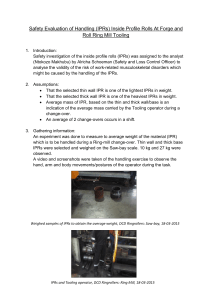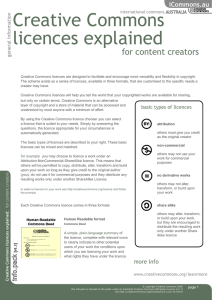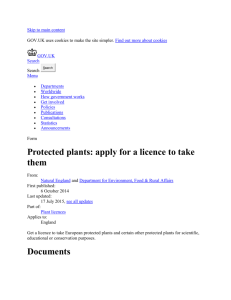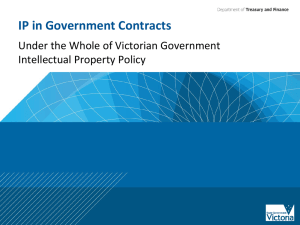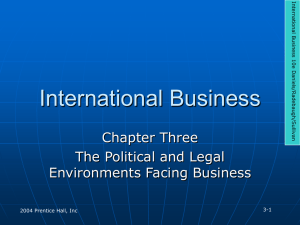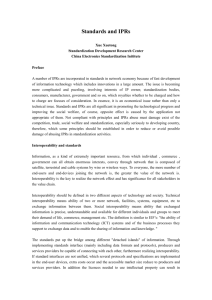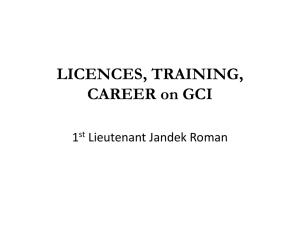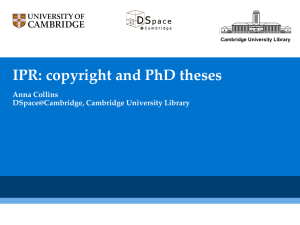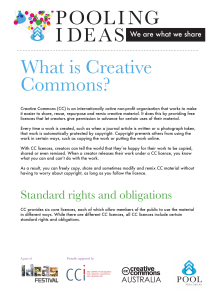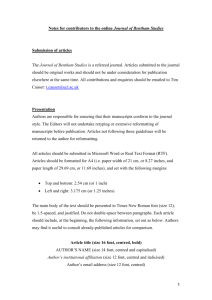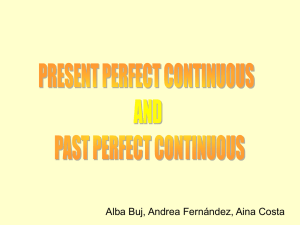Andrew Charlesworth Director, Centre for IT & Law
advertisement
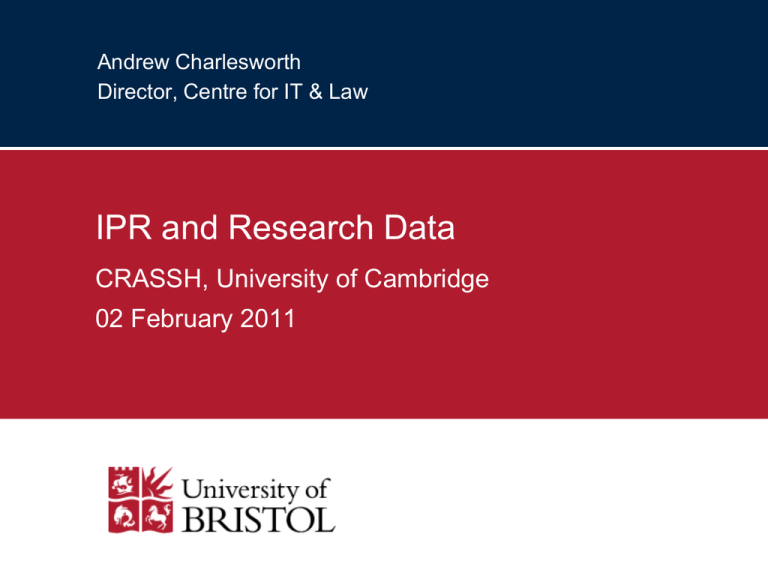
Andrew Charlesworth Director, Centre for IT & Law IPR and Research Data CRASSH, University of Cambridge 02 February 2011 2 Intellectual Property Law • Intellectual property rights (IPRs) allow individuals to claim and exercise rights in their creative and innovative works • Some IPRs are well known (if poorly understood) – copyright, patent, designs, and trademark • Others are known primarily to specialists – trade secrets, geographical indications, semiconductor chip topography rights, plant varieties and performers rights. • A work may be protected by several IPRs. 3 Copyright in the UK • UK primary legislation - Copyright, Designs and Patents Act 1988 (CDPA 1998) as amended. – http://www.ipo.gov.uk/cdpact1988.pdf (324 pages) • Works covered include: literary, dramatic, musical, artistic works, sound recordings, broadcasts, films, published editions • Copyright has been expanded (often controversially) to cover new types of works – Computer programs – UK Copyright (Computer Programs) Regulations 1992 – Databases – UK Copyright and Rights in Databases Regulations 1997 4 Copyright in the UK 2 • UK copyright law – protects ‘expressions of ideas’ not ‘ideas’ – requires that the work be ‘original’ and created in a permanent form – does not require formal registration • Duration of © protection varies – Literary works (inc. software) = author’s life + 70 years; – Sound recordings/broadcasts = 50 years from end of year created or 50 years from end of year first released. – Databases = 15 years, but may be renewed if substantial change to database 5 Copyright in the UK 3 • Ownership – the original owner of © in a given work is usually the person who created it. BUT there are exceptions e.g. – © in works created in the course of employment - the employer (issue of what is ‘in the course of’) – © in a sound recording or film - the person who made the arrangements for its creation – © in a computer-generated literary, dramatic, musical or artistic work - the person who made the arrangements for its creation. 6 Copyright in the UK 4 • Several copyrights may subsist simultaneously in a single item – A song - the words may be © as a literary work, the music may be © as a musical work, sheet music may be © as a typographical arrangement. – These ©s might be held by different people, and might have different commencement and expiry dates. 7 Copyright in the UK 5 • A rightsholder has the exclusive right to do certain things with their work - making a copy, public performance, broadcasting - ‘bundle of rights’. – These rights can be assigned, licensed, inherited etc. as a bundle, or as individual rights. • © infringement occurs when you copy a work (or a substantial part of a work) without authority of the © holder (unless legally permitted – fair dealing). • Licensing of © is common – the rightsholder grants permission to others to do certain things with the work, but retains overall control of it – lawful use of work is conditional on obeying the licence terms. 8 Permitted Acts • There are things that you can do with a © work without the rightholder’s permission, e.g. – Fair dealing – such as purposes of non-commercial research, private study, criticism and review. – Certain uses in education – Certain uses by librarians or archivists • These exceptions are very tightly constructed and construed. • Note: Fair dealing is probably the most misunderstood and misused term in © 9 The Creative Commons • Creative Commons Licences are © licences. – work can only be CC licensed by rightsholder – can’t be used to prevent © exceptions - fair dealing – can’t be used to protect things not protected by © - ideas • Creative Commons licenses are non-revocable. • Works under a Creative Commons licence must be used by licencees in accordance with its terms. • Key CC terms: – Attribution, NonCommercial, NoDerivatives and ShareAlike • CC licences can vary considerably in scope. 10 Assignment and licensing out • If you wish to let third parties use your copyright work you can : – Assign the rights in the work – Use an ad hoc licence between yourself and the users of your copyright work. – Use a licence for particular works on a case-by-case basis from a collective licensing agency – Use a blanket licence enabling access to a range of works under a fixed set of terms – Permit use under a Creative Commons licence – Dedicate the copyright work to the public domain 11 Enforcement of Copyright • The primary remedies under UK law are civil remedies e.g. injunctions and damages – Many infringements are inadvertent – infringer is unaware of © in a work, or ignorant of © generally they are still potentially liable – The burden of proof in a civil case is lower than a criminal case - balance of probability – If a case goes to court legal action tends to be both lengthy and costly (and poor PR) • Note: 1st rule of litigation - don’t sue poor people. – Exception: unless the client wants to prove a point • Note: Universities aren’t perceived as poor. 12 Research data issues • Is the research data capable of protection by copyright? – E.g. some research data may simply fail to qualify. • If it can be copyrighted, who owns it? – E.g. the researcher, the researcher’s employer, other third parties, joint ownership with others? • If third parties have rights in the data, what rights do you have to use them? • If you’ve licensed rights in, have you licensed all the rights that you need to carry out the research, disseminate the results and where necessary archive the research data. 13 Research project issues • Legal risk assessment • Ownership of rights and IPR strategy – e.g. relationship with publishers, sponsors etc. • Multi-party projects – prior agreements on IPR e.g. consortium agreement – ownership, sharing, reuse • If using 3rd party IPRs, document terms of use for each work – assignment, licence or other – rights register • If archiving data ensure that IPR information is included for archivists to guide permissible reuse • Where possible, attach IPR information to digital works as metadata. Case Study 1 –Preservation 14 • Interactive BBC videodiscs to celebrate 900th anniversary of original Domesday Book – info. about how Britain in 1986 – Preservation issues – Emulation of software to preserve the project – Copying of works held in original videodiscs • Legal issues – Copyright in software and other works – Ability to legally copy for preservation Case Study 2 – Digitisation 15 • BioMed Image Archive at Bristol University • Digitisation project - biomedical images • Legal issues: – Licensing IPRs required for archiving and dissemination of images & allowing educational use – Obtaining warranties and indemnifications to shield the University of Bristol, from unnecessary liabilities – Securing sufficient and accurate info. from the depositor to create adequate metadata to describe the image, and ensure its proper use. – Addressing data protection and confidentiality issues in subject matter of the images and in descriptive metadata Case Study 3 – Web Archiving 16 • JISC & Wellcome Trust Web Archiving Study • Broad overview of legal issues of concern to web archivists – National laws on legal deposit of digital materials; – Intellectual Property laws, esp. copyright; – Defamation law, esp. libel law; – Privacy law, esp. data protection law; – Content liability laws, esp. obscenity/indecency laws. Case Study 4 - User Generated Content • Digital Lives project personal digital collections – how modern PDCs are created, managed, and made accessible – how to select, describe, preserve and provide access to PDCs – impacts of legislation, confidentiality and professional ethics on PDCs and the implications for their dissemination, or acquisition by repositories.
